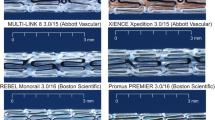Summary
In Europe more than fifty stents are currently available for the therapy of coronary artery disease. Nonetheless it is unknown whether material and design influence the stent‘s behavior. We have studied the recoil and dilatation behavior of five currently available stainless steel (316L) stents compared to stent prototypes made of pure titanium. Furthermore we have investigated how the behavior is influenced by the process of crimping. The aim of this work was to determine material and design characteristics, which influence the recoil and dilatation behavior.¶ The 316L stents showed a homogeneous behavior (plateau pressure min. 1.15±0.01 atm, max. 0.26±0.03 atm, recoil min. 0.15±0.03%, max. 0.26±0.03%). The titanium stent showed a linear response to the ballon expansion. This was seen in a significantly lower plateau pressure (0.43±0.15 atm, p<0.001). Despite the material characteristics of titanium, there were no significant differences in the recoil behavior (0.28±0.02%). Crimping leads to stent alterations which result in a significantly higher plateau pressure (1.9±0.07 atm vs. 2.7±0.58 atm, p<0.001) and a reduced enddiameter (3.6±0.02 mm vs. 3.54±0.05 mm, p<0.005).¶ The presented data show that the dilatation behavior is relying on the stent material while the recoil is strongly influenced by the stent design.
Zusammenfassung
Für die Therapie der Koronarstenose werden derzeit in Europa über 50 Stents angeboten. Inwieweit das Stentverhalten durch Material und Design beeinflusst werden, ist dabei weitgehend unbekannt. In der vorgelegten Arbeit werden Dilatations- und Recoilverhalten von fünf marktgängigen Stents und Stentprototypen aus Reintitan untersucht. Des Weiteren beschäftigt sich diese Arbeit mit dem Einfluss des Krimpvorganges auf das Stentverhalten. Ziel der Arbeit ist es, den Einfluss von Material- und Designkriterien auf das Dilatations- und Recoilverhalten zu untersuchen.¶ Die Stents aus 316L Stahl zeigten ein insgesamt homogenes Dilatations- und Recoilverhalten („Plateudruck” min. 1,15±0,01 atm, max. 0,26±0,03 atm, Recoil min. 0,15±0,03%, max. 0,26±0,03%). Der Titanstent wies ein direktes Ansprechen des Stents auf den Ballon auf. Dies zeigte sich in einem signifikant erniedrigten „Plateaudruck” (Druckniveau, bei dem es zum plötzlichen Aufspringen des Stents kommt; 0,43±0,15 atm, p<0,001). Trotz der Materialeigenschaften von Titan kam es zu keinem signifikanten Unterschied im Recoilverhalten (0,28±0,02%). Der Krimpvorgang führt zu Stentveränderungen, welche mit einem signifikant höheren Plateaudruck (1,9±0,07 atm vs. 2,7±0,58 atm, p<0,001) und einem geringeren Enddurchmesser (3,6±0,02 mm vs. 3,54±0,05 mm, p<0,005) einhergehen.¶ Die hier vorgestellten Daten zeigen, dass das Dilatationsverhalten vom verwendeten Material, das Recoilverhalten jedoch vorwiegend designabhängig ist.
Similar content being viewed by others
Author information
Authors and Affiliations
Additional information
Eingegangen: 29. Oktober 1999/Akzeptiert: 27. Januar 2000
Rights and permissions
About this article
Cite this article
Mahr, P., Fischer, A., Brauer, H. et al. Biophysikalische Prüfung koronarer Stents: Welche Faktoren beeinflussen das Dilatations- und Recoilverhalten?. Z Kardiol 89, 513–521 (2000). https://doi.org/10.1007/s003920070223
Issue Date:
DOI: https://doi.org/10.1007/s003920070223




